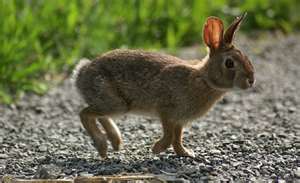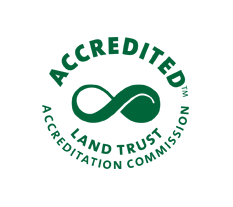 Did you know that the rabbits in our backyards are relative newcomers to Lyme? They are most likely Eastern Cottontails, imported by hunters around the turn of the twentieth century from west of the Hudson River. Until then, the only cottontail rabbit in New England was the New England Cottontail.
Did you know that the rabbits in our backyards are relative newcomers to Lyme? They are most likely Eastern Cottontails, imported by hunters around the turn of the twentieth century from west of the Hudson River. Until then, the only cottontail rabbit in New England was the New England Cottontail.
On Sunday March 11 at Lyme Public Hall, LLT sponsored a presentation by Park Ranger Shaun Roche and Wildlife Biologist Kristina Vagos, both of the US Fish and Wildlife Service’s Stewart B. McKinney Refuge in Westbrook. Shaun and Kris showed slides and answered questions about the past, present, and future of this elusive native rabbit.
The New England cottontail, unlike its more adaptable Eastern cottontail cousin, likes a very particular kind of habitat which has largely disappeared in our area since the mid-twentieth century. Our native rabbit’s preferred home is an “early successional” landscape, which means one that is in between grassland and forest, with lots of dense and tangled thickets that provide both shelter and food for the cottontails. The rabbits need a place to hide from hawks, cats, coyotes, and other predators that can see them clearly on a green lawn or in a farm field, or atop any kind of bare ground covered with snow.
These in-between landscapes are what we have the least of in Connecticut, and their disappearance threatens not only the New England Cottontail but also other species such as the prairie warbler, blue-spotted salamander, ruffed grouse, indigo bunting, wood turtle, and American woodcock.
The bad news is that no one paid much attention to this problem until recently. The good news is that it’s not too late. US Fish and Wildlife, all the New England states, and other agencies are working to find remaining New England cottontail populations, and restore habitat that is welcoming for them.
Now you’re probably wondering about the bunnies in your own backyard, and what you can do to help. Of course, supporting your local land trust is one way, since land trusts partner with state and federal government to preserve wildlife corridors and to create appropriate habitat for endangered species. You also can go to NewEnglandCottontail.org to find detailed information about the rabbit’s life cycle and preferred habitat in a downloadable “Landowner’s Guide to New England Cottontail Habitat Management.”






